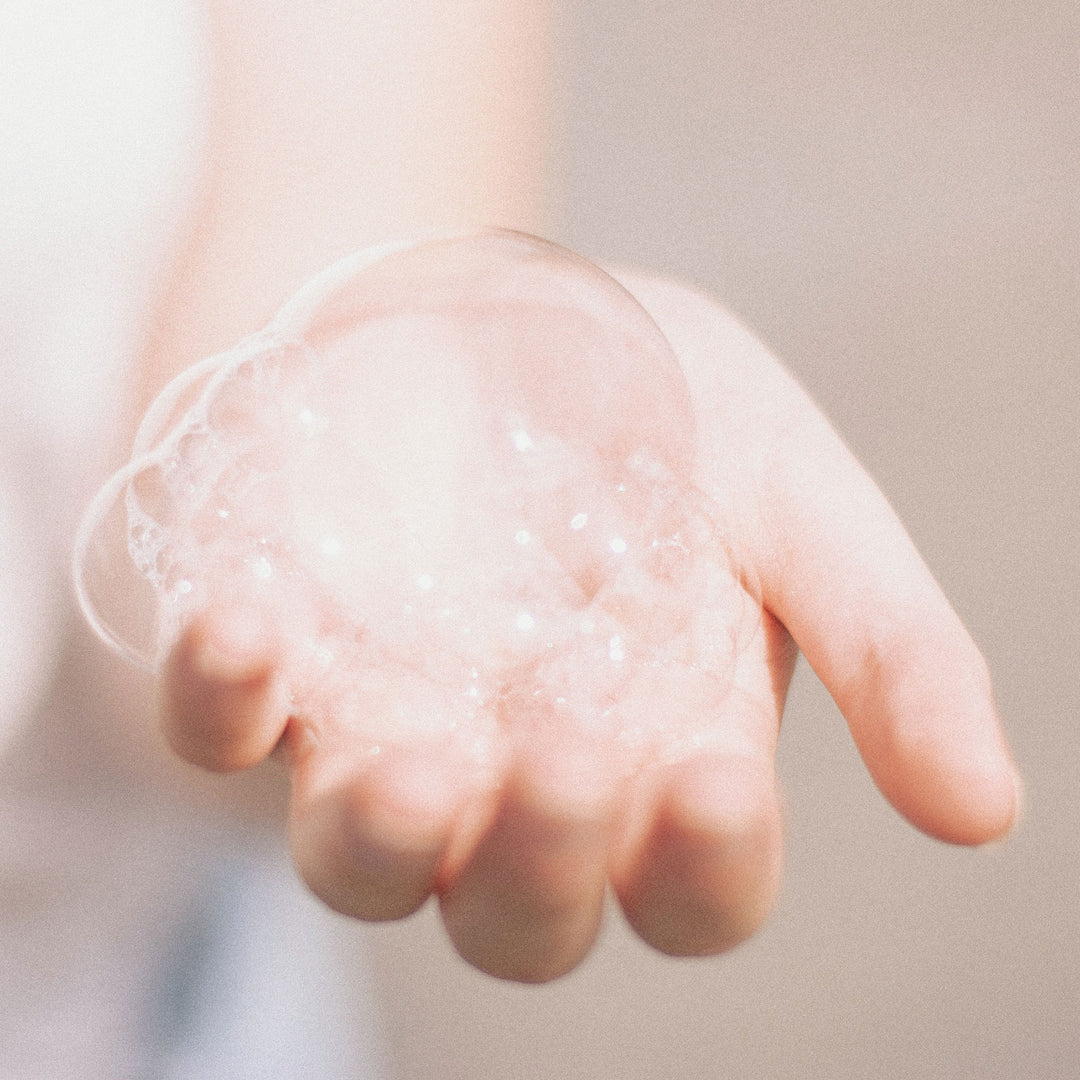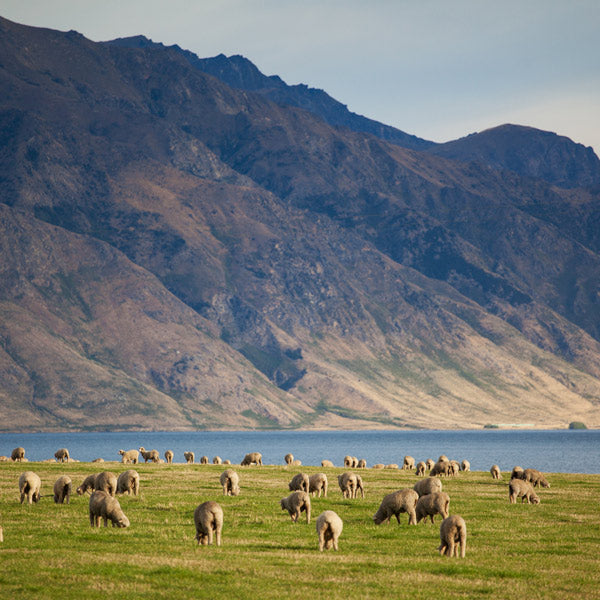Merino Care Guide
Looking after Merino wool is easy if you know how. This magical fibre differs slightly from more common fabrics like cotton and synthetics so following these tips will see you get the very best from your wool.

General Care
Something to know about modern 'non-bio' formulations is that they are only designed to remove light or background dirt from clothing.
For heavy soiling or where staining is likely a PRE-treatment is strongly advised (some things are super-stainers i.e baby poop, milk, banana, tomato sauce etc).
Unfortunately, machine washing tends to 'set' any stains not removed in one go, making them much harder to remove.
Since bleaches and oxy-soaks are NOT wool safe, they are not an option down the line. The good news is, done correctly, pre-treatment is very effective
PRE-TREATMENT STEPS:
1. Act Fast
Merino has a natural coating that will resist stains for a time, the earlier you act the less chance
the soiling has to penetrate the outer coating of the wool - so rinse off as much in cold water as quickly as possible and pre-treat as soon as you can.
2. Pre-Treat
Rinse away any solids, then use a specialist laundry stain soap or 'gall' soap - or - get a good squirt of dishwashing liquid and work it really well into the stained/soiled area. Rinse + repeat (if you need to) but don't rinse it out before laundering
3. Launder as usual, using either your normal non bio laundry liquid - or - for a superstainer (baby poop springs to mind) you can add a biological detergent as an exception instead. Biological
detergents contain extra enzymes that lift out proteins and fats so they are helpful here. Bio formulations are not recommended for ongoing use on wool, but occasional 'emergency use' is ok. If you do use biological detergent, it would be a good idea to rewash with your usual non biological detergent afterwards, since the enzymes in those detergents can leave residues and irritate
sensitive skins.
Note
- The reason we advise PRE treatment in this way is that bleaches and 'oxy' products i.e Napisan, Vanish etc (designed for use if laudering leaves residual staining). Unlike biological
detergents - which are not recommended long term - but will not ruin wool immediately - Oxy soaks and bleaches will dissolve the structure of wool fibres pretty much instantly.
- If you are out and about and do not have access to dishwashing liquid, just use any soap you can lay your hands on. Rinse in cold
water, add the soap, work well into the stain then leave until you are home and repeat with dish liquid.
If you are reading this and your little one has been or is ill, we hope they are on the mend now and we'd like to offer our commiserations to you - we know just how extremely tired you'll be right now.
The good news is
that Merino wool is VERY powerfully and naturally antibacterial, so nasty bugs will not stay active within the fibres like other fabrics. No bleaches or boil washes needed. Another miracle from mother
nature, no doubt to help those free ranging sheep, who aren't into taking baths
That said, it's a good idea to do the following to avoid any staining from setting in from the proteins and fats that will likely be present within the vomited fluids
Rinse away any solids with cold water then add a squirt of dishwashing liquid. Work
well into the area. If you have 'gall soap' this is also very good to use as it contains natural wool-safe enzymes.
Launder at slightly hotter temperatures than usual (up to 50 is fine) and use a biological laundry liquid (as a one off deep clean will not harm the garments) bios have enzymes in that help with the removal of things like vomit, but they can irritate skin so a quick second wash with the usual non bio liquid afterwards is a good idea. Also, adding white vinegar (or a solution of citric acid @ 1/2 cup to a litre of water) will help neutralize any last residues (from both the vomit and the detergents) so it is worth adding to the softener compartment. It also happens to
restore the wool back to an ideal pH too - which is a nice bonus.
If you can't get to it immediately, put your item into a bucket of cold water with a squirt of dish liquid until you can deal with it
Pilling is probably better termed the appearance of pilling, as the little fluffs and bobbles you sometimes see after the initial couple of washes, are not
the same thing as true pilling (that you see on synthetics & which never go away)
In fact, the fluffing / bobbling you may see is really just a temporary phase and will
resolve itself.
Ironically the softer the fibre and the more generous and luxurious the knit, the more the garment is prone to this appearance. This is because it is caused by a natural process whereby any shorter fibres that have been
caught up in the fibre pile during knitting, naturally work their way
to the surface of the fabric.
The good news is that any pilling or fluffing will naturally slough away with a little more wash and wear, leaving your Merino smoother and silkier than it was even brand new
If you want to speed things up, you can wash your merino alongside a coarse fabric like
denim or (carefully) use a fabric shaver or comb.
Moths love Merino (who can blame them) but it is truly heartbreaking to get a beloved item out of storage and find it riddled with holes.
Moths are attracted to protein residue found on clothing. So if your Merino will be stored or sitting unworn for a while, we recommend ensuring it is sparkling clean first.
If you notice moths and are worried they may have laid eggs (very hard to tell) then
place your knit in a bag and pop it in the freezer for 24 hours.
You can also purchase cedarwood balls or blocks to keep away the moths. Just place
those in your drawers.
Essential oils such as cedar and lavender can be soaked into a piece of wood or wiped over a drawer liner and will also help keep the moths away.
If you do notice a sudden set of holes in your garment or are having persistent moth issues, get in touch with us here for advice
Washing Merino
The good news is that Merino wool requires very little washing as it has self-cleaning properties due to the keratin in the wool that breaks down bacteria.
Our wool is 100% machine washable and designed to be machine washed on a regular cycle at 30-40 degrees.
Avoid gentle or wool specific cycles as these are designed for hand knits or non washable wool. The disadvantage is that they lack both agitation and spin
and thus leave garments much less thoroughly cleaned & very wet. Our Merino is specially constructed to be as tough and easy care, as it is soft so is perfectly fine in a regular cycle.
We recommend using
wool friendly or non-biological washing liquids day-to-day
Bio detergents (that
contain enzymes that are non wool safe) are not generally recommended for regular use with wool - but can be
used occasionally for severe soiling. Refer to our stain guidance for more detail
Powder detergents are ok but
can be abrasive and specks can get stuck in the knit, so we recommend pre-dissolving if you use powder. Liquid detergents are generally preferred.
It is not necessary to use a wool specific or delicate specific product unless you want to. Regular non-bio will work just fine.
Standard fabric softeners are not well suited to wool, they do not actually soften laundry, rather
they coat it with a petrochemical solution (so it just feels softer). This can clog the breathable fibres of the wool and reduce performance.
Most 'crispy' laundry is the result of soap residues and / or hard
water deposits
Merino itself does not ever need
softening. But if you have a sleeping bag and the outer cotton feels like it needs a bit of something, you can add white vinegar or citric acid solution (1/2 c to 1 litre of H20) to the softener drawer instead. These gentle solutions remove soap residues from clothing. Doing this not only softens the cotton layer, it also restores wool to its ideal PH as a bonus
From time to time, reconditioning your merino is a good idea, to restore lustre and softness where excessive wash and wear may have stripped it back. Any product with natural lanolin as an ingredient will work well here. We especially like 'Woolcare' by Sonnet
Getting the settings on the machine right and using wool safe products is a big part of ensuring your Merino lasts a long time. There are also some tips to ensure mechanical damage doesn't occur
1. ALWAYS close sleeping bag zips. washing machines agitate quickly and the zipper pull or free end of the zip pin can fly about in there and create damage to the knit. Closing the zip fully beforehand ensures all those parts of the zips are safely tucked away
2. Consider what else is sharing the same wash cycle. Bra hooks, velcro, hoody zips and potruding buttons can all snag merino knits so close them up before they share a wash with your merino
3. Colours. Becuase Merino wool fibres are so good at wicking moisture, they readily absorb dyes. This is a good thing as our garments are extremely washfast - and it is also why your Superlove looks so new for so long when cotton items tend to washfade. BUT the flipside of this is that lighter merino garments are more prone to absorbing free-dyes leaching from other items, that are not so colourfast. It is best not to wash light Merino with dark non Merino garments (jeans etc) especially if they are quite new.
Becuase those cycles don't clean as well as regular cycles so aren't really effective enough for next-to-skin items or childrenswear. Gentle cycles are designed for hand knitted woolens that cannot handle anything else. Our Merino is designed to be durable, strong, shrinkproof and machine washable on regular cycles.
The other issue with gentle / wool cycles is that they don't spin much - so leave behind a lot of moisture - making for long dry times, especially for sleeping bags with a cotton outer layer - those need a proper spin speed to remove water and dry well.
No. It's not necessary to pre-wash our garments. Our Merino is Bluesign Certified and our Cotton is GOTS and Oeko-tex-100. Between these certifications, you can rest assured that no nasty substances are ever used at any stage in any of our products so they do not need pre-washing. Usually, the main reason for washing new garments is to remove harmful residues, textile treatments or chemical coatings that may be present from the manufacturing of the textiles.
Sadly, as a general rule, unless you know and trust a brand is producing like we are, there are some very harmful substances routinely being used in textile processing, chemicals that you don't want anywhere near your little one. So if in doubt, pre-wash well. A good tip is to add 1 cup of white vinegar & soak new items well before washing.
Check our full care guide out here
Honestly, only if it is really soiled. Merino is naturally antimicrobial and repels dust, so it really doesn't need much washing, To freshen it,
just hang it out to air.
Likewise Merino sleeping bags do not need washing unless very dirty, just unzip and hang over the cot-rail to air out and it will stay fresh as a daisy.
Drying Merino
You can tumble dry your 100% Merino garments on LOW setting.
However, we don't recommend tumbling for Merino Sleeping Bags with cotton outers. The reason is that tumble drying will increase the shrinkage to the cotton layer by a few extra % points. Even extremely high quality cottons (like ours) have a tendancy towards shrinkage when tumbled. A few extra %
shrinkage is often not that noticeable on a small garment, but can be a bit more so on a larger one like a sleeping bag that has a zip etc. That said, a tumble on low will not usually create major shrinkage, and we are aware that many of our customers do tumble, our official position is that for best results it is better to air dry.
Yes and No.
It's generally fine to hang merino in the sun - and sunlight does have a natural bleaching effect, but do be aware that prolonged exposure to strong sunlight can have a slight photo-yellowing effect on wool. This is only a consideration for very light shades though. You can turn garments inside out to protect against this though. It's not an issue for cotton outers of sleeping bags
Merino is very fast drying so this is really useful in the winter. Usually it just needs to be hung or draped somewhere relatively warm.
No heat is needed, it will dry much faster than cotton.
If you want to speed the process up a warm radiator is also fine and so are heated rails. We've never observed any undue shrinkage or ill effects from that.
Merino knits structures behave a bit like chewing gum, they are stretchy and compliant and they move about in the wash, often rearranging themselves in the garment to be longer and skinnier. A quick reshape just resets the knit to a balanced state. It's not essential, as just wearing the garment will do a similar thing, it's just a nice extra step if you have time. It's a good idea for baby sleeping bags to gently stretch the fabric back out along the zipline - this avoids the zip looking 'wavy'










